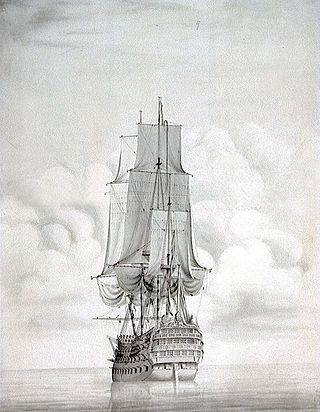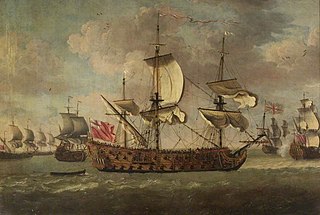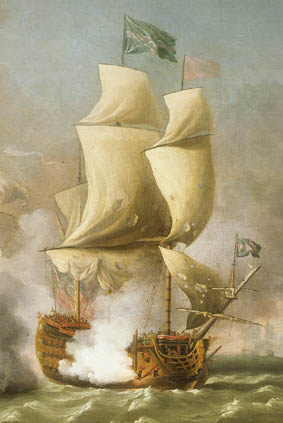
HMS Vanguard was a 90-gun second-rate ship of the line of the Royal Navy, built at Portsmouth Dockyard and launched in 1678.

HMS Cornwall was an 80-gun, third rate, ship of the line built for the Royal Navy in the 1690s. She served in the War of the Grand Alliance, and in her first year took part in the Battle of Barfleur and the action at La Hougue.

HMS Culloden was a 74-gun third-rate ship of the line of the Royal Navy, built according to the dimensions laid out by the 1741 proposals of the 1719 Establishment at Deptford Dockyard, and launched on 9 September 1747. She was the first ship to bear the name, and was named for the Battle of Culloden, which had been fought the previous year.

HMS Devonshire was a 74-gun third rate ship of the line of the Royal Navy, launched on 23 September 1812 at Deptford.

HMS Falkland was a 50-gun fourth-rate ship of the line of the Royal Navy, built by Holland of New Castle, New Hampshire, and purchased by the navy in 1696.

HMS Swiftsure was a 70-gun third-rate ship of the line of the Royal Navy, built by Sir Anthony Deane at Harwich, and launched in 1673. By 1685 she had been reduced to a 66-gun ship.

President was a 38-gun fourth rate frigate of the Royal Navy, originally built for the navy of the Commonwealth of England by Peter Pett I at Deptford Dockyard, and launched in 1650.

HMS Devonshire was an 80-gun third rate ship of the line of the Royal Navy, launched at Bursledon on 5 April 1692.

HMS Boyne was an 80-gun third-rate ship of the line of the Royal Navy, launched at Deptford Dockyard on 21 May 1692.

HMS Russell was an 80-gun third rate ship of the line of the Royal Navy, launched at Portsmouth Dockyard on 3 June 1692.

HMS Humber was an 80-gun third rate ship of the line of the Royal Navy, launched at Hull on 30 March 1693.
HMS Torbay was an 80-gun third rate ship of the line of the Royal Navy, launched at Deptford Dockyard on 16 December 1693. In 1707, she served as flagship of Rear-Admiral of the Blue Sir John Norris and belonged to Admiral Sir Cloudesley Shovell's fleet. She saw action during the unsuccessful Battle of Toulon and was present during the great naval disaster off the Isles of Scilly when Shovell and four of his ships were lost, claiming the lives of nearly 2,000 sailors. Torbay suffered little to no damage and finally managed to reach Portsmouth.

HMS Lancaster was an 80-gun third rate ship of the line of the Royal Navy, launched at Bursledon on 3 April 1694.
HMS Dorsetshire, the first Royal Navy ship to be named after the county of Dorset, was an 80-gun third rate ship of the line of the Royal Navy, launched at Southampton on 8 December 1694.

HMS Newark was an 80-gun third rate ship of the line of the Royal Navy, launched at Hull on 3 June 1695.
HMS Shrewsbury was a three-decker 80-gun third-rate ship of the line of the Royal Navy, built by Joseph Allin the elder and launched at Portsmouth Dockyard on 6 February, 1695.

HMS Barfleur was a 90-gun second rate ship of the line of the Royal Navy, launched at Deptford Dockyard on 10 August 1697.

HMS Lichfield was a 50-gun fourth-rate ship of the line of the Royal Navy, built at Portsmouth Dockyard and launched on 4 February 1695.

HMS Cumberland was a three-deck 80-gun third rate ship of the line of the Royal Navy, built by Joseph Allin the elder at Deptford Dockyard and launched on 27 December 1710. Her design corresponded to that laid down by the 1706 Establishment of dimensions for 80-gun ships.

HMS Devonshire was a 66-gun third rate ship of the line of the Royal Navy, built to the dimensions laid out in the 1741 proposals of the 1719 Establishment at Woolwich Dockyard, and launched on 19 July 1745.














